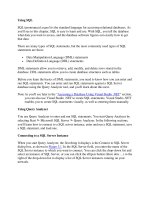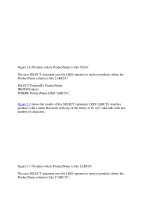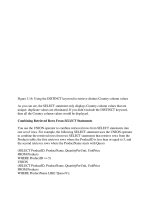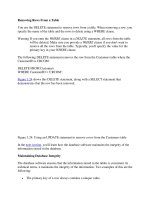Tài liệu Using SQL *Plus to Create Report and Manage Pl/SQL code doc
Bạn đang xem bản rút gọn của tài liệu. Xem và tải ngay bản đầy đủ của tài liệu tại đây (297.45 KB, 50 trang )
Using SQL*Plus to Create
Reports and Manage PL/SQL
Code
C
Introduction to Oracle: SQL and PL/SQL Using Procedure BuilderCĆ2
Using SQL*Plus to Create Reports and Manage PL/SQL Code CĆ3
Objectives
This lesson covers formatting query output to produce simple reports,
controlling the SQL*Plus environment, and manipulating PL/SQL code using
SQL*Plus.
At the end of this lesson, you should be able to
D Differentiate between SQL and SQL*Plus commands.
D Identify SET commands used to control the SQL*Plus environment.
D Customize reports using SQL*Plus formatting commands.
D Create and modify anonymous blocks and program units with SQL*Plus and the
online editor.
D Execute SQL*Plus commands, anonymous blocks, program units, and SQL
statements.
D Compile procedures and functions.
D Embed messages to assist with debugging code.
Introduction to Oracle: SQL and PL/SQL Using Procedure BuilderCĆ4
The SQL*Plus Environment
Using SQL*Plus to Create Reports and Manage PL/SQL Code CĆ5
Overview
SQL*Plus is an environment in which you can
D Execute SQL statements to retrieve, modify, add, and remove data from database
tables.
D Format, perform calculations on, store, and print query results in the form of
reports.
D Issue SQL statements to create, alter, and remove database tables.
D Create anonymous blocks, subprograms, database triggers using procedural
language extension, PL/SQL.
SQL*Plus has a variety of commands you need to use to execute subprograms, pass
values in and out of PL/SQL blocks, and debug your code.
SQL*Plus commands may be divided into the following main categories.
Category
Purpose
Environment Affects the general behavior of SQL statements for the
session.
Format Formats query results.
File manipulation Saves, loads, and runs script files.
Execution Sends SQL or PL/SQL commands from SQL buffer to
Oracle7 Server.
Edit Modifies SQL commands in the buffer.
Interaction Allows users to create and pass variables to SQL
statements, print variable values, and print messages to
the screen.
Miscellaneous Various commands to connect to the database,
manipulate the SQL*Plus environment, and display
column definitions.
Introduction to Oracle: SQL and PL/SQL Using Procedure BuilderCĆ6
Entering Commands in SQL*Plus
Using SQL*Plus to Create Reports and Manage PL/SQL Code CĆ7
Entering Commands in SQL*Plus
Once you log in to SQL*Plus, you see the command prompt. Issue all your
commands at this prompt. Three types of commands can be entered at this prompt.
D SQL commands to manipulate data and structures in the database.
D SQL*Plus command to format query results, set the environment, edit commands,
and create variables.
D PL/SQL blocks to work with information in the database in a procedural method.
To execute commands, type them at the command prompt. SQL*Plus commands do
not need to be terminated with a semicolon (;). SQL statements and PL/SQL blocks
do need to be terminated with a semicolon to send the statement to the Oracle7
Server.
Introduction to Oracle: SQL and PL/SQL Using Procedure BuilderCĆ8
Using SQL*Plus to Create Reports and Manage PL/SQL Code CĆ9
Comparison of SQL and SQL*Plus Commands
This table compares SQL and SQL*Plus commands. They are distinctly different
programs, but are used together to perform some tasks, such as to format data in a
report and to control command files.
SQL
SQL*Plus
Is a language for communicating with
the Oracle Server to access data.
Recognizes SQL commands, and sends
them to the server.
Is based on American National
Standards Institute (ANSI) standard
SQL.
Is the Oracle proprietary interface for
executing SQL commands.
Manipulates data and table definitions in
the database.
Does not allow you to manipulate values
in the database.
Is entered into the SQL*Buffer on one or
more lines.
Is entered one line at a time; not stored
in the SQL buffer.
Does not have a continuation character. Has a dash “-” as a continuation
character if the command is longer than
one line.
Cannot be abbreviated. Can be abbreviated.
Uses a termination character to execute
commands required.
Does not require termination characters;
commands are immediately executed.
Uses functions to perform some
formatting.
Uses commands to format data.
Introduction to Oracle: SQL and PL/SQL Using Procedure BuilderCĆ10
Using SQL*Plus to Create Reports and Manage PL/SQL Code CĆ11
SQL*Plus SET Commands
Control the environment in which SQL*Plus is currently operating by using the SET
commands.
Syntax
SET system_variable value
where: system_variable is a variable that controls one aspect of the
session environment.
value is a value for the system variable.
Default Settings Using the login.sql File
The login.sql file contains standard SET and other SQL*Plus commands that you
may require for every session. The file is read and commands are implemented at log
in. When you log out of your session, all customized setting are lost.
Changing the Default Settings
The settings implemented by login.sql can be changed during the current session.
Changes made are only current for that session. As soon as you log out, those settings
are lost.
Add permanent changes to settings to the login.sql file.
For more information, see
SQL*Plus User’s Guide and Reference, Release 3.3, “Command Reference.”
Introduction to Oracle: SQL and PL/SQL Using Procedure BuilderCĆ12
Using SQL*Plus to Create Reports and Manage PL/SQL Code CĆ13
SQL* Plus SET Commands
Some Useful SET Commands
SET Variable and Values
Description
ARRAY[SIZE] {20|n} Sets the database data fetch size.
COLSEP { |text} Sets text to be printed between columns. Default
is single space.
FEED[BACK] {6|n|OFF|ON} Displays the number of records returned by a
query when the query selects at least n records.
HEA[DING]{OFF|ON} Determine whether column headings are
displayed in reports.
LIN[ESIZE] {80|n} Sets the number of characters per line to n for
reports.
LONG {80|n} Sets maximum width for displaying LONG
values.
PAGES[IZE] {24|n} Specifies the number of lines per page of output.
PAU[SE] {OFF|ON|text} Allows you to control scrolling of your terminal.
You must press [Return] after seeing each pause.
TERM[OUT] {OFF|ON} Determines whether output is displayed to the
screen.
Guidelines
D Use the SHOW command to view current values for any of these settings, for
example SHOW PAUSE. To see all SET variable values, use the SHOW ALL
command.
D The value n represents a numeric value.
D Underlined values shown above indicate default values. If you enter no value with
the variable, then SQL*Plus assumes the default value.
Introduction to Oracle: SQL and PL/SQL Using Procedure BuilderCĆ14
Using SQL*Plus to Create Reports and Manage PL/SQL Code CĆ15
Creating a Report
Script File
You can create a script file (or command file) that includes both a SQL SELECT
statement and SQL*Plus commands used to format and reset command values. Script
files are useful for saving both a SQL statement and any SQL*Plus settings specific
to that statement.
Additionally, you can create a file to hold all your default SQL*Plus commands,
which may be executed at any time to reset your settings. This file can be executed
from within your command file.
SQL*Plus Format Commands
You can control the report features described above by using the following
commands:
Command
Purpose
COL[UMN] [column option] Controls column formats.
TTI[TLE] [text|OFF|ON] Specifies a header to appear at the top of each
page of the report.
BTI[TLE] [text|OFF|ON] Specifies a footer to appear at the bottom of
each page of the report.
Guidelines
D All format commands remain in effect until the end of the SQL*Plus session, or
until the format setting is overwritten or cleared.
D Remember to reset your SQL*Plus settings to default values after every report.
D There is no command for setting a SQL*Plus variable to its default value; you
must know the specific value or log out and log in again.
D If you give an alias to your column, you must reference the alias name, not the
column name.
Introduction to Oracle: SQL and PL/SQL Using Procedure BuilderCĆ16
Using SQL*Plus to Create Reports and Manage PL/SQL Code CĆ17
Creating a Report continued
TTITLE and BTITLE Commands
Use the TTITLE command to format page headers and the BTITLE command for
footers. Footers appear at the end of the page according to the PAGESIZE value.
Syntax
The syntax for BTITLE and TTITLE is identical. Only the TTITLE syntax is shown.
You can use the vertical bar (|) to split the text of the title across several lines.
TTI[TLE] [printspec [text|variable]][OFF|ON]
where: printspec is an option to specify the type of settings.
text represents the title text. Enter single quotes if
the text is more than one word.
variable is a system-maintained value.
Example
Set the report header to display Salary centered on one line, and Report centered
below it.
SQL> TTITLE ’Salary|Report’
Display or Clear Settings
To show or clear the current header and footer command settings, use the following
commands.
Command
Description
TTITLE Displays the current setting for the header.
TTITLE OFF Turns the header off.
BTITLE Displays the current setting for the footer.
BTITLE OFF Turns the footer off.
Introduction to Oracle: SQL and PL/SQL Using Procedure BuilderCĆ18
Using SQL*Plus to Create Reports and Manage PL/SQL Code CĆ19
Creating a Report continued
Creating the Script File to Run a Report
You can either enter each of the SQL*Plus commands at the SQL prompt or put all
the commands, including the SELECT statement, in a command (or script) file. A
typical script consists of at least one SELECT statement and several SQL*Plus
commands.
Steps to Create a Script File
1. Create the SQL SELECT statement at the SQL prompt. Ensure that the data
required for the report is accurate before you save the statement to a file and
apply formatting commands. Ensure that the relevant ORDER BY clause is
included if you intend to use breaks.
2. Save the SELECT statement to a script file.
3. Edit the script file to enter the SQL*Plus commands.
4. Add the required formatting commands before the SELECT statement. Be certain
not to place SQL*Plus commands within the SELECT statement.
5. Verify that the SELECT statement is followed by a run character, either a
semicolon (;) or a slash (/).
6. Add the format-clearing SQL*Plus commands after the run character. As an
alternative, you can call a reset file which contains all the format-clearing
commands.
7. Save the script file with your changes.
8. In SQL*Plus, run the script file by entering START filename or @filename. This
command is required to read and execute the script file.
Guidelines
D You can include blank lines between SQL*Plus commands in a script.
D You can abbreviate SQL*Plus commands.
D Include reset commands at the end of the file in order to restore the original
SQL*Plus environment.
Introduction to Oracle: SQL and PL/SQL Using Procedure BuilderCĆ20
1
2
3
Header1 Column labels and
format
2 Footer3
Using SQL*Plus to Create Reports and Manage PL/SQL Code CĆ21
Creating a Report continued
Example
Create a script file to create a report which displays the job title, last name, and salary
for every employee who is not a vice president or a warehouse manager. Add a
centered, two-lined header that reads Employee Report, and a centered footer that
reads Confidential. Rename the title column to read Job Category split over two lines.
Rename the employee name column to read Employee. Print the salary column with
the label in initial capitalization and formatted as $2,500.00.
REM ** This report covers all employees who are not
REM ** vice presidents or warehouse managers.
SET ECHO OFF
SET PAGESIZE 37
SET LINESIZE 60
SET FEEDBACK OFF
TTITLE ’Employee|Report’
BTITLE ’Confidential’
COLUMN title HEADING ’Job|Category’ FORMAT A22
COLUMN last_name HEADING ’Employee’ FORMAT A22
COLUMN salary HEADING ’Salary’ FORMAT $99,999.99
REM ** Insert SELECT statement
SELECT title, last_name, salary
FROM s_emp
WHERE title NOT LIKE ’VP%’
AND title <> ’Warehouse Manager’
ORDER BY title, last_name, salary
/
REM ** Run a reset command file
START reset.sql
SET ECHO ON
REM represents a remark or comment in SQL*Plus.
Introduction to Oracle: SQL and PL/SQL Using Procedure BuilderCĆ22
Declaring and Creating PL/SQL Blocks
Using SQL*Plus to Create Reports and Manage PL/SQL Code CĆ23
Declaring and Creating PL/SQL Blocks
You can use two methods to process PL/SQL blocks in SQL*Plus.
D Define a block in the SQL buffer, then execute the contents of the buffer.
D Define a block as part of a SQL*Plus script file, then start the file.
Declaring PL/SQL Blocks in the SQL Buffer
A PL/SQL block is treated as one continuous statement in the buffer, and the
semicolons (;) within the block do not close or execute the contents of the buffer.
SQL*Plus detects the start of a PL/SQL block when you enter either DECLARE or
BEGIN at the prompt. You can close the buffer without executing the block by
entering a period (.) at the number prompt of the buffer.
To run the buffered PL/SQL block, enter the RUN command or a slash (“/”) at the
prompt. If the block executes successfully, without unhandled exceptions or compile
errors, you will see a message.
Creating SQL*Plus Files Containing PL/SQL Blocks
You can include PL/SQL blocks in files of SQL and SQL*Plus commands. Create the
file using the operating system editor. SQL*Plus commands may not occur inside the
PL/SQL block itself, but you can include them elsewhere in the file.
You can reference SQL*Plus substitution variables inside the block, but remember
that they are substituted with the variable’s contents before the code is parsed or
executed. This means that if you reference a SQL*Plus substitution variable in a
PL/SQL loop, then a value is substituted for the variable once, and not for each
iteration of the loop.
Introduction to Oracle: SQL and PL/SQL Using Procedure BuilderCĆ24
SQL*Plus Commands
Using SQL*Plus to Create Reports and Manage PL/SQL Code CĆ25
Entering Commands in SQL*Plus
SQL*Plus contains an array of commands to format reports and initiate the users’
environment.
SQL*Plus Command
Description
ACCEPT Reads input from the user and stores the input into a
variable.
VARIABLE Declares a bind, or host, variable that can be
referenced in PL/SQL with a preceding colon (:).
PRINT Displays the current value of bind variables.
EXECUTE Executes a single PL/SQL statement.
For more information, see
SQL*Plus User’s Guide and Reference, Release 3.3.









